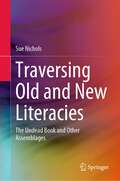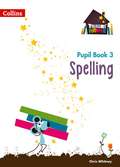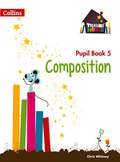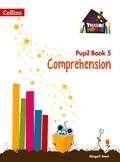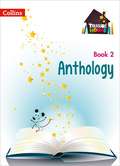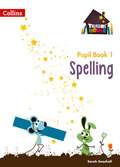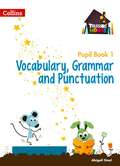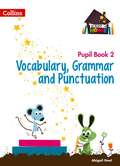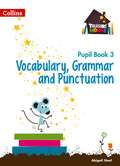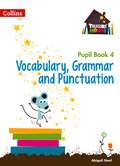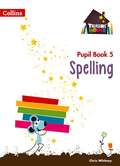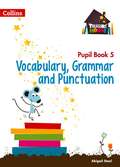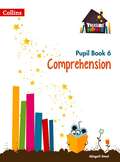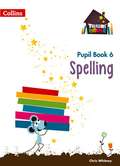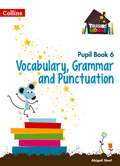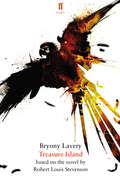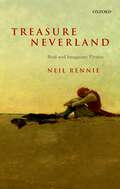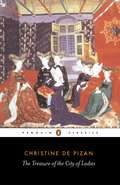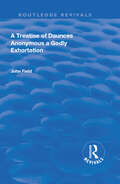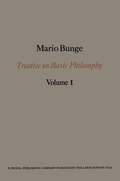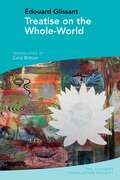- Table View
- List View
Traversing Old and New Literacies: The Undead Book and Other Assemblages
by Sue NicholsThis book re-examines the field of New Literacy Studies and promotes a shift away from binary constructions of literacies as 'old' or 'new' and to encourage critical reflection on the part of readers as to the uses of these constructs. First, the book examines the entanglement of pasts, presents and futures in contemporary literacy practices. Second, it considers representations of literacies as actors, having their own power and consequences. Third, it critically examines the place of 'new' and 'old' literacies in a marketplace in which social, economic and political power advantage is contested. The book demonstrates the use of assemblage theory drawing on semiotics, geo-semiotics and Actor Network Theory for analyzing literacies as assemblages. It provides readers with tools of analysis with which to interrogate claims made for the value of literacy, innovations and traditions alike. It also discusses implications for literacy policy, curriculum, teacher education and research.
Treasure House: Pupil Book 3 (PDF)
by Chris WhitneyTreasure House: Spelling Pupil Books are aimed at ages 6-11, offering complete coverage of the demanding 2014 National Curriculum, and ideal practice of the all the spelling rules in the new GAPS test.
Treasure House — Year 5 Composition Pupil Book (PDF)
by Chris WhitneyTreasure House: Composition Pupil Books are aimed at ages 6-11. They include both classic and contemporary fiction and non-fiction, which stimulate children to think, talk and write for a range of purposes. This Treasure House pupil book: * covers all the composition skills in the 2014 National Curriculum * includes a wide variety of fiction and non-fiction extracts, with detailed annotations explaining how each showcases a particular composition skill * accompanies each extract with carefully structured questions, building up to a piece of writing * ensures pupils will become assured, proficient writers.
Treasure House — Year 5 Comprehension Pupil Book (PDF)
by Abigail SteelTreasure House: Comprehension Pupil Books are aimed at ages 6-11. They cover all the text types specified in the 214 National Curriculum, with follow-up activities that build the skills necessary to develop critical thinking. This Treasure House pupil book: * covers a wide variety of fiction and non-fiction genres * builds enjoyment of comprehension skills on a range of top-quality texts * contains carefully tailored questions that cover all the statutory requirements of the 2014 National Curriculum * ensures pupils will become accomplished critical thinkers
Treasure House Anthology Book 2
by CollinsThis beautifully illustrated anthology is an indispensable collection of extracts from well-loved children’s books. Featuring fiction from Michael Morpurgo, Allan Ahlberg and Oliver Jeffers as well as quality non-fiction, you can use the texts as a springboard for your own teaching ideas or with Teacher’s Guide 2 for a complete English programme. Treasure House Anthology 2 will inspire a love of reading.
Treasure House, Year 1 Spelling Pupil Book (PDF)
by Sarah SnashallTreasure House: Spelling Pupil Books are aimed at ages 6-11, offering complete coverage of the demanding 2014 National Curriculum, and ideal practice of the all the spelling rules in the new GAPS test. This Treasure House pupil book: is matched directly to the 2014 National Curriculum explains each spelling rule clearly and simply, followed by a set of carefully tailored questions ensures pupils will master all appropriate language skills.
Treasure House, Year 1 Spelling Pupil Book (PDF)
by Sarah SnashallTreasure House: Spelling Pupil Books are aimed at ages 6-11, offering complete coverage of the demanding 2014 National Curriculum, and ideal practice of the all the spelling rules in the new GAPS test. This Treasure House pupil book: is matched directly to the 2014 National Curriculum explains each spelling rule clearly and simply, followed by a set of carefully tailored questions ensures pupils will master all appropriate language skills.
Treasure House, Year 1 Vocabulary, Grammar and Punctuation Pupil Book (PDF)
by Abigail SteelTreasure House: Vocabulary, Grammar and Punctuation Pupil Books are aimed at ages 6-11, offering complete coverage of the demanding 2014 National Curriculum, and ideal practice of the skills in the new GAPS test
Treasure House, Year 2 Vocabulary, Grammar and Punctuation Pupil Book (PDF)
by Abigail SteelTreasure House: Vocabulary, Grammar and Punctuation Pupil Books are aimed at ages 6-11, offering complete coverage of the demanding 2014 National Curriculum, and ideal practice of the skills in the new GAPS test.
Treasure House, Year 3 Spelling Pupil Book (PDF)
by Chris WhitneyTreasure House: Spelling Pupil Books are aimed at ages 6-11, offering complete coverage of the demanding 2014 National Curriculum, and ideal practice of the all the spelling rules in the new GAPS test.
Treasure House, Year 3 Vocabulary, Grammar and Punctuation Pupil Book (PDF)
by Abigail SteelTreasure House: Vocabulary, Grammar and Punctuation Pupil Books are aimed at ages 6-11, offering complete coverage of the demanding 2014 National Curriculum, and ideal practice of the skills in the new GAPS test.
Treasure House, Year 4 Vocabulary, Grammar and Punctuation Pupil Book (PDF)
by Abigail SteelTreasure House: Vocabulary, Grammar and Punctuation Pupil Books are aimed at ages 6-11, offering complete coverage of the demanding 2014 National Curriculum, and ideal practice of the skills in the new GAPS test. This
Treasure House, Year 5 Spelling Pupil Book (PDF)
by Sarah SnashallTreasure House: Spelling Pupil Books are aimed at ages 6-11, offering complete coverage of the demanding 2014 National Curriculum, and ideal practice of the all the spelling rules in the new GAPS test.
Treasure House, Year 5 Spelling Pupil Book (PDF)
by Sarah SnashallTreasure House: Spelling Pupil Books are aimed at ages 6-11, offering complete coverage of the demanding 2014 National Curriculum, and ideal practice of the all the spelling rules in the new GAPS test.
Treasure House, Year 5 Vocabulary, Grammar and Punctuation Pupil Book (PDF)
by Abigail SteelTreasure House: Vocabulary, Grammar and Punctuation Pupil Books are aimed at ages 6-11, offering complete coverage of the demanding 2014 National Curriculum, and ideal practice of the skills in the new GAPS test. This
Treasure House - Year 6 Comprehension Pupil Book (PDF)
by Abigail SteelTreasure House: Comprehension Pupil Books are aimed at ages 6-11. They cover all the text types specified in the 2014 National Curriculum, with follow-up activities that build the skills necessary to develop critical thinking. This Treasure House pupil book: covers a wide variety of fiction and non-fiction genres builds enjoyment of comprehension skills on a range of top-quality texts contains carefully tailored questions that cover all the statutory requirements of the 2014 National Curriculum ensures pupils will become accomplished critical thinkers.
Treasure House, Year 6 Spelling Pupil Book (PDF)
by Chris WhitneyTreasure House: Spelling Pupil Books are aimed at ages 6-11, offering complete coverage of the demanding 2014 National Curriculum, and ideal practice of the all the spelling rules in the new GAPS test.
Treasure House, Year 6 Vocabulary, Grammar and Punctuation Pupil Book (PDF)
by Abigail SteelTreasure House: Vocabulary, Grammar and Punctuation Pupil Books are aimed at ages 6-11, offering complete coverage of the demanding 2014 National Curriculum, and ideal practice of the skills in the new GAPS test. This
Treasure Island
by Bryony LaveryNot one of us must breathe a word of what we've found.It's a dark and stormy night. Jim, the inn-keeper's granddaughter, opens the door to a terrifying stranger. At the old sailor's feet sits a huge sea-chest, full of secrets. Jim invites him in - and her dangerous voyage begins.Treasure Island, Robert Louis Stevenson's classic story of murder, money and mutiny, premiered at the National Theatre, London, in December 2014, in a thrilling adaptation by Bryony Lavery.
Treasure Neverland: Real and Imaginary Pirates
by Neil RennieTreasure Neverland is about factual and fictional pirates. Swashbuckling eighteenth-century pirates were the ideal pirates of all time and tales of their exploits are still popular today. Most people have heard of Blackbeard and Captain Kidd even though they lived about three hundred years ago, but most have also heard of other pirates, such as Long John Silver and Captain Hook, even though these pirates never lived at all, except in literature. The differences between these two types of pirates - real and imaginary - are not quite as stark as we might think as the real, historical pirates are themselves somewhat legendary, somewhat fictional, belonging on the page and the stage rather than on the high seas. Based on extensive research of fascninating primary material, including testimonials, narratives, legal statements, colonial and mercantile records, Neil Rennie describes the ascertainable facts of real eighteenth-century pirate lives and then investigates how such facts were subsequently transformed artistically, by writers like Defoe and Stevenson, into realistic and fantastic fictions of various kinds: historical novels, popular melodramas, boyish adventures, Hollywood films. Rennie's aim is to watch, in other words, the long dissolve from Captain Kidd to Johnny Depp. There are surprisingly few scholarly studies of the factual pirates - properly analysing the basic manuscript sources and separating those documents from popular legends - and there are even fewer literary-historical studies of the whole crew of fictional pirates, although those imaginary pirates form a distinct and coherent literary tradition. Treasure Neverland is a study of this Scots-American literary tradition and also of the interrelations between the factual and fictional pirates - pirates who are intimately related, as the nineteenth-century writings about fictional pirates began with the eighteenth-century writings about supposedly real pirates. 'What I want is the best book about the Buccaneers', wrote Stevenson when he began Treasure Island in 1881. What he received, rightly, was indeed the best book: the sensational and unreliable History of the Pyrates (1724).
The Treasure of the City of Ladies: Or the Book of the Three Virtues (Penguin Classics)
by Christine De PizanWritten by Europe’s first professional woman writer, The Treasure of the City of Ladies offers advice and guidance to women of all ages and from all levels of medieval society, from royal courtiers to prostitutes. It paints an intricate picture of daily life in the courts and streets of fifteenth-century France and gives a fascinating glimpse into the practical considerations of running a household, dressing appropriately and maintaining a reputation in all circumstances. Christine de Pizan’s book provides a valuable counterbalance to male accounts of life in the middle ages and demonstrates, often with dry humour, how a woman’s position in society could be made less precarious by following the correct etiquette.
A Treatise of Daunces and A Godly Exhortation (Routledge Revivals)
by Anonymous John FieldOriginally published in 1974, this volume contains A Treatise of Daunces, Anonymous, and A Godly Exhortation, by John Field.
Treatise on Basic Philosophy: Semantics I: Sense and Reference (Treatise on Basic Philosophy #1)
by M. BungeIn this Introduction we shall sketch a profile of our field of inquiry. This is necessary because semantics is too often mistaken for lexicography and therefore dismissed as trivial, while at other times it is disparaged for being concerned with reputedly shady characters such as meaning and allegedly defunct ones like truth. Moreover our special concern, the semantics of science, is a newcomer - at least as a systematic body - and therefore in need of an introduction. l. GOAL Semantics is the field of inquiry centrally concerned with meaning and truth. It can be empirical or nonempirical. When brought to bear on concrete objects, such as a community of speakers, semantics seeks to answer problems concerning certain linguistic facts - such as disclosing the interpretation code inherent in the language or explaning the speakers' ability or inability to utter and understand new sentences ofthe language. This kind of semantics will then be both theoretical and experimental: it will be a branch of what used to be called 'behavioral science'.
Treatise on the Whole-World: by Édouard Glissant (The Glissant Translation Project #3)
by Celia BrittonThis exciting, challenging book covers a wide range of subject matter, but all linked together through the key ideas of diversity and ‘Relation’. It sees our modern world, shaped by immigration and the aftermath of colonization, as a multiplicity of different communities interacting and evolving together, and argues passionately against all political and philosophical attempts to impose uniformity, universal or absolute values. This is the ‘Whole-World’, which includes not only these objective phenomena but also our consciousness of them. Our personal identities are not fixed and self-sufficient but formed in ‘Relation’ through our contacts with others. Glissant constantly stresses the unpredictable, ‘chaotic’ nature of the world, which, he claims, we must adapt to and not attempt to limit or control. ‘Creolization’ is not restricted to the Creole societies of the Caribbean but describes all societies in which different cultures with equal status interact to produce new configurations. This perspective produces brilliant new insights into the politicization of culture, but also language, poetry, our relationship to place and to landscapes, globalization, history, and other topics. The book is not written in the style conventionally associated with essays, but is a mixture of argument, proclamation, and poetic evocations of landscapes, lifestyles and people.
